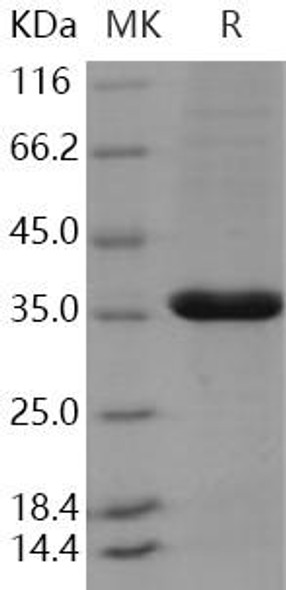Description
| Product Name: | Human PCNA Recombinant Protein |
| Product Code: | RPPB4199 |
| Size: | 25µg |
| Species: | Human |
| Target: | PCNA |
| Synonyms: | Proliferating cell nuclear antigen, PCNA, Cyclin, MGC8367. |
| Source: | Escherichia Coli |
| Physical Appearance: | Sterile Filtered colorless solution. |
| Formulation: | The PCNA solution contains 20mM Tris pH-7.5 & 2mM EDTA & 20% glycerol. |
| Stability: | Store at 4°C if entire vial will be used within 2-4 weeks. Store, frozen at -20°C for longer periods of time. For long term storage it is recommended to add a carrier protein (0.1% HSA or BSA).Avoid multiple freeze-thaw cycles. |
| Purity: | Greater than 95.0% as determined by:(a) Analysis by RP-HPLC.(b) Analysis by SDS-PAGE. |
| Amino Acid Sequence: | MFEARLVQGS ILKKVLEALK DLINEACWDI SSSGVNLQSM DSSHVSLVQLTLRSEGFDTY RCDRNLAMGV NLTSMSKILK CAGNEDIITL RAEDNADTLA LVFEAPNQEK VSDYEMKLMD LDVEQLGIPE QEYSCVVKMP SGEFARICRD LSHIGDAVVI SCAKDGVKFS ASGELGNGNI KLSQTSNVDK EEEAVTIEMN EPVQLTFALR YLNFFTKATP LSSTVTLSMS ADVPLVVEYK IADMGHLKYY LAPKIEDEEG S |
PCNA is located in the nucleus and is a cofactor of DNA polymerase delta. PCNA acts as a homotrimer and helps elevate the processivity of leading strand synthesis during DNA replication. In reaction to DNA damage, PCNA is ubiquitinated and takes part in the RAD6-dependent DNA repair pathway. 2 transcript variants encoding the same protein have been found for PCNA gene. Pseudogenes of this PCNA gene have been described on chromosome 4 and on the X chromosome. PCNA is expressed during late G1- phase, S-phase of mitosis and persists until the end of the M-phase because of its long biological half-life. PCNA is induced by UV irradiation.
PCNA Human Recombinant produced in E.Coli is a single, non-glycosylated polypeptide chain containing 261 amino acids and having a molecular mass of 28769 Dalton.
| UniProt Protein Function: | PCNA: This protein is an auxiliary protein of DNA polymerase delta and is involved in the control of eukaryotic DNA replication by increasing the polymerase's processibility during elongation of the leading strand. Induces a robust stimulatory effect on the 3'- 5' exonuclease and 3'-phosphodiesterase, but not apurinic- apyrimidinic (AP) endonuclease, APEX2 activities. Has to be loaded onto DNA in order to be able to stimulate APEX2. Homotrimer. Forms a complex with activator 1 heteropentamer in the presence of ATP. Interacts with EXO1, POLH, POLK, DNMT1, ERCC5, FEN1, CDC6 and POLDIP2. Interacts with APEX2; this interaction is triggered by reactive oxygen species and increased by misincorporation of uracil in nuclear DNA. Forms a ternary complex with DNTTIP2 and core histone. Interacts with KCTD10 and PPP1R15A. Interacts with POLD1, POLD3 and POLD4. Interacts with BAZ1B; the interaction is direct. Interacts with HLTF and SHPRH. Interacts with NUDT15. Interaction is disrupted in response to UV irradiation and acetylation. Interacts with p21Cip1/p21(CIP1) and CDT1; interacts via their PIP-box which also recruits the DCX(DTL) complex. Interacts with DDX11. Interacts with EGFR; positively regulates PCNA. Interacts with C12orf48/PARI. Interacts with SMARCAD1. Belongs to the PCNA family. |
| UniProt Protein Details: | Protein type:DNA replication; Cell cycle regulation Chromosomal Location of Human Ortholog: 20pter-p12 Cellular Component: nucleoplasm; centrosome; PCNA complex; nuclear replication fork; cytoplasm; DNA replication factor C complex; nucleus Molecular Function:identical protein binding; protein binding; DNA polymerase processivity factor activity; MutLalpha complex binding; purine-specific mismatch base pair DNA N-glycosylase activity; receptor tyrosine kinase binding; dinucleotide insertion or deletion binding Biological Process: mismatch repair; heart development; positive regulation of deoxyribonuclease activity; DNA strand elongation during DNA replication; response to lipid; DNA repair; leading strand elongation; G1/S-specific transcription in mitotic cell cycle; telomere maintenance via semi-conservative replication; cell proliferation; bypass DNA synthesis; response to cadmium ion; epithelial cell differentiation; base-excision repair; nucleotide-excision repair; transcription-coupled nucleotide-excision repair; telomere maintenance via recombination; nucleotide-excision repair, DNA gap filling; mitotic cell cycle; telomere maintenance; regulation of DNA replication; G1/S transition of mitotic cell cycle Disease: Ataxia-telangiectasia-like Disorder 2 |
| NCBI Summary: | The protein encoded by this gene is found in the nucleus and is a cofactor of DNA polymerase delta. The encoded protein acts as a homotrimer and helps increase the processivity of leading strand synthesis during DNA replication. In response to DNA damage, this protein is ubiquitinated and is involved in the RAD6-dependent DNA repair pathway. Two transcript variants encoding the same protein have been found for this gene. Pseudogenes of this gene have been described on chromosome 4 and on the X chromosome. [provided by RefSeq, Jul 2008] |
| UniProt Code: | P12004 |
| NCBI GenInfo Identifier: | 129694 |
| NCBI Gene ID: | 5111 |
| NCBI Accession: | P12004.1 |
| UniProt Secondary Accession: | P12004,B2R897, D3DW02, |
| UniProt Related Accession: | P12004 |
| Molecular Weight: | 261 |
| NCBI Full Name: | Proliferating cell nuclear antigen |
| NCBI Synonym Full Names: | proliferating cell nuclear antigen |
| NCBI Official Symbol: | PCNA�� |
| NCBI Official Synonym Symbols: | ATLD2�� |
| NCBI Protein Information: | proliferating cell nuclear antigen; cyclin; DNA polymerase delta auxiliary protein |
| UniProt Protein Name: | Proliferating cell nuclear antigen |
| UniProt Synonym Protein Names: | Cyclin |
| Protein Family: | PCNA-associated factor |
| UniProt Gene Name: | PCNA�� |
| UniProt Entry Name: | PCNA_HUMAN |






